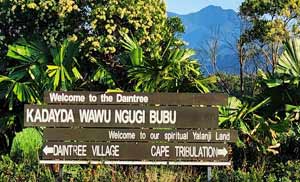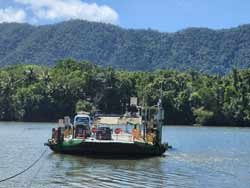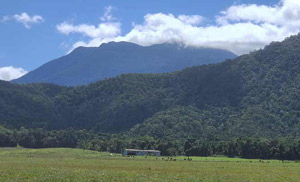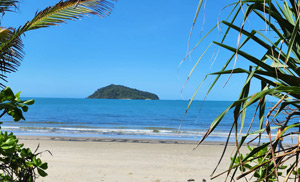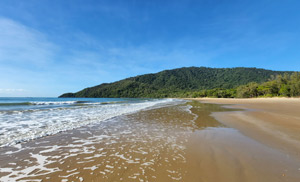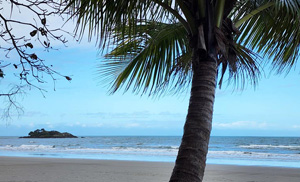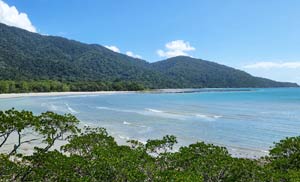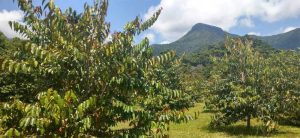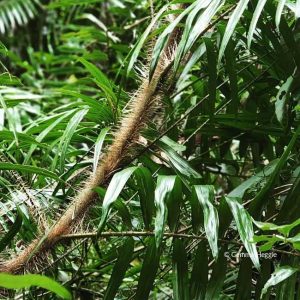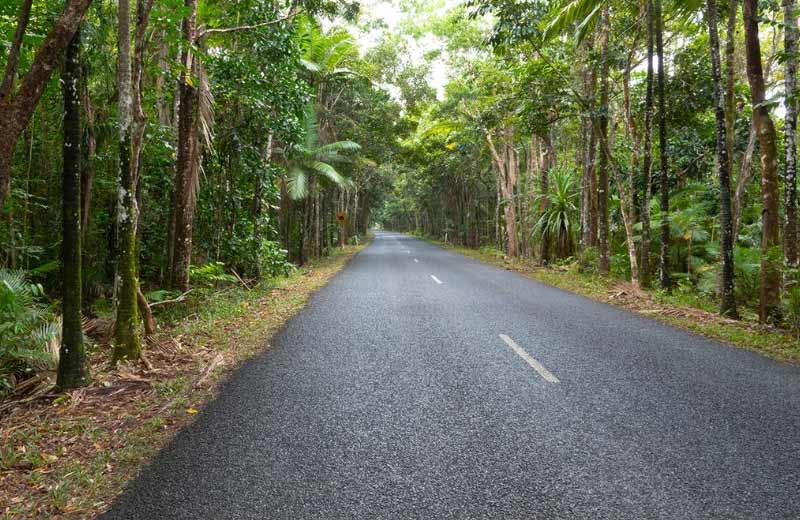Visitors to the Daintree Rainforest experience the wonders of walking through an ancient forest with spectacular canopies, flowing creeks and amazing biodiversity.
You may be alert to creepy crawlies that live in the jungle – such as bugs and spiders and wary of possibly spotting a snake whilst exploring the rainforest boardwalks, or perhaps a crocodile on a river tour – but this place of incredible wilderness also has some plants you should avoid coming into contact with.
Below are some of the dangerous plants of the Daintree Rainforest.
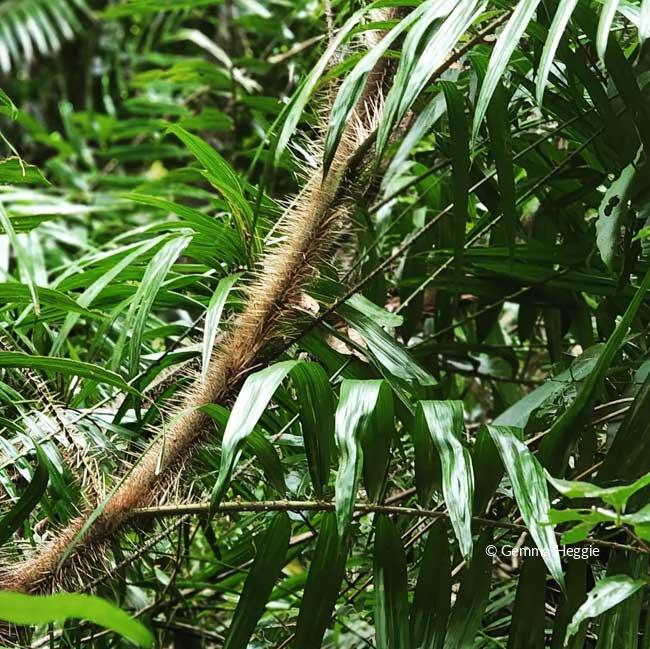
First off the list of dangerous plants to avoid contact with in the Daintree Rainforest is…
wait-a-while
Calamus australis, commonly known as lawyer cane, wait-a-while, or hairy mary, is a climbing palm endemic to Queensland.
The plant has numerous hooks along its leaf sheath, along its leaves, and a long whip-like flagellum stretching out to 3m.
Unfortunate people who come into contact with this plant are forced to ‘wait-a-while’ trying to disentangle themselves and pull out the painful barbs.
It’s notorious in the Daintree rainforest and it’s safest viewed from the rainforest boardwalks – though it often overhangs the walkways, so you need to watch out!
This plant has many amazing Indigenous uses – the older smooth canes can be used for weaving, tying and construction purposes. An acidic drink is made by squashing the edible fruit in water. The thin, outer fleshy layer of the fruit is a traditional bush tucker. Young tips were chewed, to cure stomach upsets. The long flexible spined tendrils were also used to pull witchetty grubs from holes in timber. The cane from this plant was later used for making furniture and crab pots.
The name says it all with this next dangerous plant of the Daintree Rainforest …
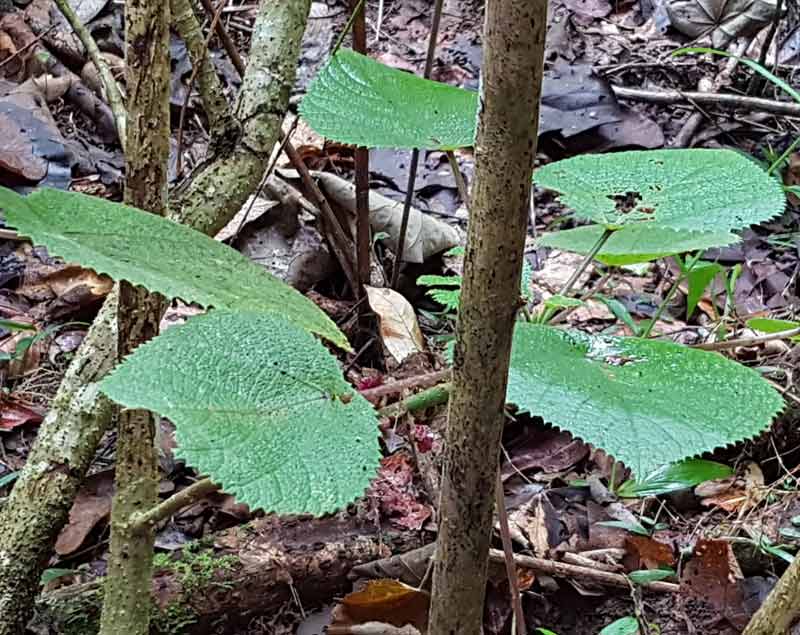
Stinging Tree
It may not look as menacing as wait-a-while… but the Stinging Tree is not to be messed with!
Stinging Tree or Stinging Bush is common in Daintree rainforest especially on the edges of the forest or in disturbed areas. It is a member of the Urticaceae – stinging nettle family.
The leaves and stems are covered in fine hairs that, if touched, inflict a painful sting. The hairs are made of the main constituent of glass – silica. If you brush against them, their tips penetrate the skin, break off, and release an irritant poison.
The effect of this sting may last for months.
Victims who have encountered the wrath of the Stinging Tree often say “Once stung – never forgotten!“. The sting has described by some as as being intensely painful and it can come back again months later.
For some, the plant can also cause an allergic reaction causing extreme itching, hives and painful burning sensations.
Unfortunately there is no known cure for Stinging Tree stings.
If you’re unfortunate to get stung, suggested treatments include:
Treatment 1: First do not rub the area! This can break off the hairs and make them very difficult to remove. Remove visible hairs with tweezers. Apply and remove adhesive tape or hair-removal wax strips to the affected area to remove the finer hairs. You may need to apply steroid cream if the reaction intensifies,
Treatment 2: Another treatment that many swear by (but unfortunately doesn’t work for all) includes making a solution 3% hydrochloric acid and water (Hydrochloric acid generally comes as a 30% solution – dilute this to around 1-9 with water) – use plastic or glass containers and utensils. Lay a strip of paper towel or tissue over the affected area, and gently pour the acid mix over it until saturated. IT WILL STING!! – for apparently 5-10 minutes then the pain should subside. Follow this with an application of wax strips (such as Waxeeze) spread on the affected area, leave the strip for a few minutes then rip it off in a fast movement. This will help remove the stinging hairs. Repeat the wax strip procedure until all the hairs are removed. More on this treatment here.
N.b Duct Tape can also be used if you don’t have any wax strips!
Treatment 3: Use the hydrochloric acid mix as described above and then apply a spray bandage that can be purchased at pharmacies and supermarkets. The spray bandage will sting when applied and provides a second-skin to the area and for some has helped to reduce the pain and severity.
If you’re planning to go bush walking – you might like to keep the above suggested treatments available in your first aid kit. Many who are affected by the Stinging Tree continue to feel repeated painful sensations when the affected area is touched by water. Some have needed to wax and clean the area multiple times after being affected.
Consult a doctor is any symptoms persist.
Next up is a plant that looks inviting… the glossy leaves and attractive fruit are appealing… but look out!

Tar Tree
This is a Semecarpus australiensis, commonly known as the tar tree, native cashew, marking nut, or cedar plum. It is related to the mango tree and the leaves are dark green on top and lighter underneath.
It is a common tree of coastal lowland rainforests and can be found throughout the Daintree Rainforest.
The black tar-like sap of this tree is caustic, and can cause severe allergic reactions. Symptoms include but not limited to blistering, sores, and swelling, which can be incapacitating. It can cause blindness if it comes in contact with the eyes.
The fruit (which is actually a nut) is also toxic in their natural state to humans.
Cassowaries however love them and Indigenous communities have developed ways to remove the fleshy orange parts of the fruits and roasting them before eating – avoiding direct contact at all times and also avoiding inhalation of the smoke.
Any contact with the plant has been noted to cause serious reactions. This is definitely a tree to be wary of!
If you stick to the provided boardwalks or wander the Daintree Rainforest with a trained guide, you should be fine to experience the natural beauty and diversity of the Dantree without any nasty encounters. However it’s always good to know what to look out for – just in case.
